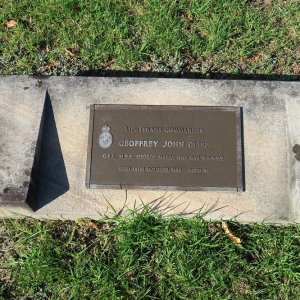- SURNAME
Cliff
- FORENAME
Geoffrey John
- UNIT
HMS President, Royal Australian Naval Volunteer Reserve
- RANK
Lieutenant + Lieutenant Commander
- NUMBER
- AWARD
Officer of the Order of the British Empire, Member of the Order of the British Empire, George Medal and bar
- PLACE
UK - London Gazette 9.6.1942 (GM) 24.11.1942 (bar GM) 28.9.1943 (MBE) 18.4.1944 (OBE)
- ADDITIONAL INFORMATION
born 14.8.1907 Beecroft, New South Wales, Australia
next of kin Richard Cliff
commissioned 6.1.1941
bomb disposal, UK
discharged 18.9.1946 (Lt, HMAS Rushcutter)
died 14.10.1988 Concord, New South Wales, Australia. (Aged 81)
Field of Mars Cemetery, Ryde, New South Wales, Australia.
London Gazette 35591, 5th June 1942, Page 2548 (GM)
London Gazette 35797, 20th November 1942, Page 5107 (GM Bar)
London Gazette 36188, 24th September 1943, Page 4315 (MBE)
London Gazette 36474, 14th April 1944, Page 1775 (OBE)
Geoffrey John (Jack) Cliff (1907-1988), civil engineer and naval officer, was born on 14 August 1907 at Beecroft, New South Wales, son of Richard Charles Cliff, a Sydney-born engineer, and his wife Adelaide Gertrude Orontes, née Goss, who had been born at sea. Jack attended Sydney Church of England Grammar School (Shore) in 1922-24. He later became a civil engineer, working for Coolah Shire Council in 1934-38 and the Snowy River Shire in 1939-40.
On 1 January 1941 Cliff was appointed probationary sub-lieutenant, Royal Australian Naval Volunteer Reserve, under the Yachtsmen Scheme. He was then 5 ft 7½ ins (171 cm) tall, with fair hair and blue eyes. Sent to England for training at HMS King Alfred, he was promoted to provisional lieutenant in April and posted to the Admiralty’s land incident section, which disarmed and disposed of German magnetic and acoustic mines dropped by parachute across the British Isles. He used his engineering skills to defuse mines that had penetrated deep below ground, thus earning the nickname `Contractor Jack’. Peter Firkins described him as slightly eccentric, a confirmed bachelor with a remarkable capacity for drinking beer. He was a bright and jovial man with a hearty laugh.
In May 1941 Cliff made his way through the debris of a two-storey building at Bermondsey, London, to reach an unexploded parachute mine. A nearby mine or bomb detonated, nearly burying him in wreckage. Realising that the explosion had probably started the clockwork fuse of the parachute mine, he extricated himself and rendered it safe. On another occasion he dealt with a mine buried in 24 ft (7.31 m) of clay at Leysdown, Kent. This weapon was even more dangerous than usual as it had been badly damaged in its fall and was fitted with an anti-handling device operated by a photoelectric cell. For his `gallantry and undaunted devotion to duty’ in these and other operations, both on land and under water, he was awarded the George Medal in June 1942.
Cliff won a Bar to his GM for defusing mines in Belfast at the sewerage works and in the town reservoir in June 1942. For `great bravery and steadfast devotion to duty’ in other actions he was appointed MBE in September 1943. That month he was promoted to acting lieutenant commander. He was elevated to OBE in April 1944. In October he and his colleague L. V. Goldsworthy were transferred to the Pacific as liaison officers with the United States Navy’s Mobile Explosives Investigation Unit No.1. Cliff’s RANVR appointment terminated on 29 January 1946. That year he returned to London as a member of the Australian contingent for the Victory March.
After the war Cliff resumed his career as a civil engineer with various shires of New South Wales. In 1955-58 he was the chief roads engineer for the British protectorate Brunei, Borneo. A member of the Imperial Service Club, Sydney, and the Dee Why sub-branch of the Returned Services League of Australia, he enjoyed the company of friends at the Collaroy Services Beach Club on Sunday mornings. He listed golf as his recreation. In later years he was devoted to his dogs and garden. He died on 14 October 1988 at the Repatriation General Hospital, Concord, and was buried in the Field of Mars cemetery, Ryde.
Source : https://adb.anu.edu.au/biography/cliff-geoffrey-john-jack-12327
WEB LINKS:
• https://www.thegazette.co.uk/London/issue/35591/supplement/2548 (GM)• https://www.thegazette.co.uk/London/issue/35797/supplement/5107 (GM Bar)
• https://www.thegazette.co.uk/London/issue/36188/page/4315 (MBE)
• https://www.thegazette.co.uk/London/issue/36474/supplement/1775 (OBE)
• https://adb.anu.edu.au/biography/cliff-geoffrey-john-jack-12327
FINDAGRAVE:
https://www.findagrave.com/memorial/123624327/geoffrey-cliffSERVICE HISTORY:
View Digital Image
Last edited by a moderator:




